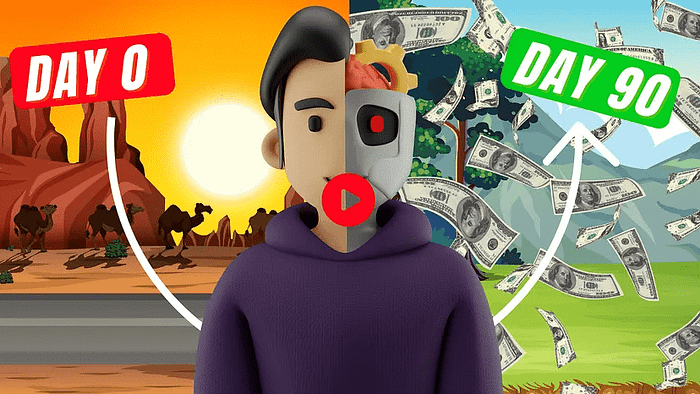If you’re ready to start a blog and are passionate about a particular topic, sharing your knowledge with the world is an excellent way to express your ideas and connect with like-minded individuals. When you start a blog, you have the opportunity to potentially turn your passion into a profitable venture. In this article, we’ll guide you through the process of how to start a blog and create a thriving community around your content.
Before we dive into the details, it’s essential to understand that building a successful blog takes time, effort, and dedication. However, with the right strategies and mindset, you can start a blog that attracts a loyal readership and fosters a vibrant community. Let’s begin this exciting journey together and explore how you can effectively start a blog!
We strongly recommend that you check out our guide on how to take advantage of AI in today’s passive income economy.
Table of Contents
Choosing Your Niche and Defining Your Target Audience
The first step to start a blog is to identify your niche and target audience. Your niche is the specific topic or theme that your blog will focus on. It could be anything from cooking and lifestyle to technology and personal finance. When selecting your niche, choose a subject that you’re passionate about and have knowledge or experience in.
Once you’ve determined your niche, it’s crucial to define your target audience. Who are the people you want to reach with your blog? Consider factors such as age, gender, interests, and pain points. Understanding your target audience will help you create content that resonates with them and addresses their needs.
When you start a blog, it’s tempting to try to appeal to everyone. However, focusing on a specific niche and target audience will help you establish yourself as an authority in your chosen field. By providing valuable and relevant content, you’ll attract readers who are genuinely interested in what you have to offer.
Setting Up Your Blog: Platform, Domain, and Hosting
Now that you have a clear idea of your niche and target audience, it’s time to set up your blog. The first decision you’ll need to make is choosing a blogging platform. There are several options available, such as WordPress, Squarespace, and Wix. Each platform has its own features and benefits, so research and select the one that best suits your needs.
Next, you’ll need to choose a domain name for your blog. Your domain name is the URL that people will use to access your website. It should be memorable, easy to spell, and relevant to your niche. Once you’ve chosen your domain name, you’ll need to register it with a domain registrar.
After securing your domain name, you’ll need to choose a hosting provider. Web hosting is a service that allows your blog to be accessible on the internet. There are various hosting options available, including shared hosting, virtual private server (VPS) hosting, and dedicated hosting. As a beginner, shared hosting is often the most cost-effective option.
When you start a blog, investing in a reliable hosting provider is essential. A good hosting service ensures that your blog is always accessible to your readers and provides adequate security measures to protect your website from potential threats.
Designing Your Blog: Theme, Layout, and Branding
With your blog set up, it’s time to focus on its design and branding. The visual appearance of your blog plays a crucial role in attracting and retaining readers. Choose a theme that aligns with your niche and target audience. Many blogging platforms offer a wide range of pre-designed themes that you can customize to suit your preferences.
When selecting a theme, consider factors such as readability, navigation, and responsiveness. Your blog should be easy to read, with a clear font and adequate spacing between paragraphs. The navigation should be intuitive, allowing readers to find the content they’re looking for quickly. Additionally, ensure that your blog is mobile-friendly, as many people access websites through their smartphones and tablets.
Your blog’s branding should reflect your personality and the essence of your niche. Choose a color scheme, logo, and imagery that represents your blog’s identity. Consistency is key when it comes to branding. Use the same colors, fonts, and style across your blog to create a cohesive and professional look.
Remember, when you start a blog, your design and branding should create a welcoming and engaging environment for your readers. A visually appealing and user-friendly blog will encourage visitors to explore your content and stay connected with your community.
Creating Compelling Content: Engaging Your Audience
At the heart of a successful blog is compelling content. Your content should be informative, valuable, and engaging. When you start a blog, focus on creating content that addresses the needs and interests of your target audience. Share your knowledge, experiences, and insights in a way that resonates with your readers.
To create compelling content, start by researching your niche and identifying the topics that your target audience is searching for. Use keyword research tools to discover popular search terms and phrases related to your niche. Incorporate these keywords naturally into your blog posts to improve your search engine rankings and attract organic traffic.
When writing your blog posts, aim for a conversational and relatable tone. Write as if you’re speaking directly to your readers, addressing their pain points and offering solutions. Use storytelling techniques to make your content more engaging and memorable. Include personal anecdotes, case studies, and examples to illustrate your points.
In addition to written content, consider incorporating visuals such as images, infographics, and videos into your blog posts. Visual content can break up long blocks of text, making your posts more digestible and shareable. When selecting visuals, ensure that they are high-quality, relevant to your content, and properly attributed if sourced from external sites.
Consistency is crucial when it comes to creating content for your blog. Establish a regular posting schedule and stick to it. Whether you choose to publish new posts weekly, bi-weekly, or monthly, let your readers know when they can expect fresh content from you. Consistency helps build trust and loyalty with your audience.
Building Your Community: Engagement and Interaction
A thriving blog community is built on engagement and interaction. When you start a blog, it’s essential to foster a sense of belonging and encourage your readers to participate in the conversation. Respond to comments on your blog posts, asking questions and encouraging further discussion. This shows your readers that you value their input and are invested in building relationships with them.
Engage with your readers on social media platforms as well. Share your blog posts on your social media profiles and encourage your followers to comment, like, and share. Participate in relevant online communities and forums, offering valuable insights and linking back to your blog when appropriate. This helps expand your reach and attract new readers to your blog.
Consider implementing a comment system on your blog that allows readers to easily leave feedback and engage with each other. Moderate comments to ensure a positive and respectful environment, but avoid over-moderation, as it can stifle conversation. Encourage readers to subscribe to your blog’s RSS feed or email newsletter to stay updated on new content and upcoming events.
As your blog grows, consider hosting events, webinars, or Q&A sessions to further engage with your community. These events provide an opportunity for your readers to connect with you and each other on a deeper level. You can also collaborate with other bloggers or influencers in your niche to cross-promote content and expand your reach.
Monetizing Your Blog: Transforming Your Passion into Profit
While creating a thriving community is rewarding in itself, many bloggers aspire to monetize their blogs and turn their passion into a profitable venture. There are several ways to monetize your blog, depending on your niche, audience, and goals.
One popular method is through affiliate marketing. Affiliate marketing involves promoting products or services on your blog and earning a commission when your readers make a purchase through your unique affiliate link. To succeed with affiliate marketing, choose products that align with your niche and provide genuine value to your readers. Be transparent about your affiliate relationships and only recommend products that you truly believe in.
Another way to monetize your blog is through sponsored content. Brands may approach you to create sponsored blog posts, product reviews, or social media promotions. When working with brands, ensure that the sponsored content aligns with your blog’s values and provides value to your readers. Clearly disclose sponsored content to maintain trust and transparency with your audience.
Display advertising is another common monetization strategy for bloggers. You can join ad networks like Google AdSense or Media.net, which place relevant ads on your blog. When a reader clicks on an ad, you earn a portion of the advertising revenue. To maximize your earnings, focus on increasing your blog’s traffic and optimizing ad placement for better visibility and click-through rates.
As your blog grows, you may also consider creating and selling your own digital products, such as ebooks, courses, or printables. These products allow you to share your expertise and provide additional value to your readers while generating a passive income stream.
When monetizing your blog, it’s crucial to prioritize your audience’s trust and experience. Avoid overloading your blog with ads or promoting products that don’t align with your values. Focus on providing value and building genuine relationships with your readers, and the monetization opportunities will follow naturally.
Conclusion
Starting a blog and creating a thriving community is an exciting and rewarding journey. By choosing a niche you’re passionate about, setting up your blog with a user-friendly design, creating compelling content, and fostering engagement with your readers, you can build a successful blog that makes a meaningful impact.
Remember, success doesn’t happen overnight. Building a thriving blog community takes time, effort, and patience. Stay consistent in your content creation, engage with your readers regularly, and continually improve your skills and knowledge in your niche.
As you start a blog and navigate the blogging world, don’t be afraid to experiment, learn from your mistakes, and adapt to your audience’s needs. Celebrate your successes, no matter how small, and use them as motivation to keep growing and evolving.
With dedication and perseverance, you can transform your blog into a platform that not only showcases your passion but also connects you with a vibrant community of like-minded individuals. So, start a blog today and embark on this exciting adventure. Your voice matters, and the world is waiting to hear what you have to say!
FAQ
How do bloggers get paid?
Bloggers can get paid through various methods, including:
- Affiliate marketing: Bloggers promote products or services on their blog and earn a commission when readers make a purchase through their unique affiliate link.
- Sponsored content: Brands pay bloggers to create sponsored blog posts, product reviews, or social media promotions that align with the blogger’s niche and audience.
- Display advertising: Bloggers join ad networks like Google AdSense or Media.net, which place relevant ads on their blog. When a reader clicks on an ad, the blogger earns a portion of the advertising revenue.
- Digital products: Bloggers create and sell their own digital products, such as ebooks, courses, or printables, to generate a passive income stream.
- Services: Some bloggers offer services related to their niche, such as coaching, consulting, or freelance writing, to earn money from their blog.
How do I start a blog for free?
You can start a blog for free using platforms like WordPress.com, Blogger, or Wix. These platforms offer free plans that allow you to create a blog without any upfront costs. However, free plans often come with limitations, such as limited customization options, restricted storage space, and a non-custom domain name (e.g., yourblog.wordpress.com).
To start a blog for free, simply sign up for an account with your chosen platform, select a free theme, and start creating content. Keep in mind that while starting a blog for free is possible, investing in a self-hosted blog with a custom domain name offers more flexibility and control over your blog in the long run.
How do I start a blog with no money?
Starting a blog with no money is similar to starting a blog for free. Follow these steps:
- Choose a free blogging platform like WordPress.com, Blogger, or Wix.
- Sign up for a free account with your selected platform.
- Choose a free theme that aligns with your niche and desired design.
- Create compelling content that provides value to your target audience.
- Promote your blog on social media and engage with your readers to build a community.
As your blog grows, you can consider upgrading to a paid plan or investing in a self-hosted blog to access more features and monetization opportunities.
Do beginner bloggers make money?
Beginner bloggers can make money, but it typically takes time and effort to generate a significant income. Building a successful blog requires consistently creating valuable content, growing your audience, and implementing monetization strategies.
Many beginner bloggers start by joining affiliate programs or placing display ads on their blogs. As their traffic and engagement increase, they may attract sponsored content opportunities or create their own digital products to sell.
The amount of money beginner bloggers make varies greatly depending on factors such as niche, audience size, and monetization strategies. Some beginner bloggers may earn a few dollars per month, while others may generate a part-time or full-time income within their first year of blogging.
The key to making money as a beginner blogger is to focus on providing value to your audience, building trust, and continually learning and improving your blogging skills. With dedication and persistence, beginner bloggers can lay the foundation for a profitable blogging business.

We strongly recommend that you check out our guide on how to take advantage of AI in today’s passive income economy.




